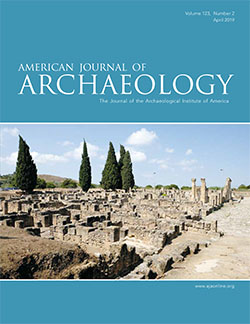AJA Open Access
BY-NCApril 2019 (123.2)
Book Review
Autour des machines de Vitruve: L’ingénierie romaine. Textes, archéologie et restitution. Actes du colloque organisé par l’ERLIS à Caen (3–4 juin 2015).
Edited by Sophie Madeleine and Philippe Fleury
Reviewed by Thomas Noble Howe
The amount of scholarship dedicated to the study of ancient scientific texts has increased in the last few decades due in good part to the studies supported by Louis Callebat at the Université de Caen Normandie, including a conference organized in 2010 (P. Fleury, C. Jacquemard, and S. Madeleine, eds., La technologie gréco-romaine: Trasmission, restitution et mediation [Caen 2015]). The current volume continues this research, and most of the authors consider the less-studied aspects of Vitruvius’ Book 10 (e.g., the construction of the carpentry of the rolling siege equipment as opposed to the much-studied and more sensational ballistae and catapultae). The focus of the earlier conference was on the transmission of Vitruvian knowledge across time and space; in this conference the focus was on the machines themselves.
The contributions are grouped by the type of machine (or its location, as in a theater), and all make new arguments. Callebat opens with a discussion of the terminology of Vitruvian machines that aims to integrate this vocabulary with both technical and sociocultural meanings. Rihill examines the “myths” of Greek creativity vs. Roman pragmatism and argues that the reasons Greeks invented most machines (excepting possibly Hero's spherical steam engine) were also fundamentally pragmatic, not pure curiosity and superior intellectual genius. Rihill suggests that the mechanism for stretching the tendons for the springs of a catapulta/ballista might function more easily horizontally than vertically; my own drawing published elsewhere shows the vertical method, but I find the suggestion logical. Sammour turns to the less-studied, and presumably simpler, siege machines of Apollodorus of Damascus: mobile wheeled siege towers and rams under armored roofs. Vitruvius’ descriptions are mystifyingly limited for the most part to the precise details of the supporting chassis, and the article moves from there to truly beautiful digital color reconstructions of the details of joinery. Guillaumain, in the contribution on references to ballistae and catapultae in Plautus, is less interested in the reconstruction of actual machines than are the other authors and more on how artillery was perceived by a broad audience (i.e., reception theory). It appears that the plays were written with the assumption that the public was broadly aware of the types of artillery that Plautus used as metaphors, or comparisons, or a combination of both, and that the terms often refer to the missile rather than the machine—in other words, the effect.
A beautifully illustrated article by one of the editors, Madeleine, proposes and analyzes three types of vela (awnings) over theaters and amphitheaters: those suspended over posts directly inserted in the seating of smaller theatres (high enough not to obscure the view from the top rows); those suspended from a ring of yardarms supported by masts on the outer periphery; and those suspended on a fan of radial lines from the outer periphery to the scaenae frons. The conclusion is that the last approach was used for larger theaters and others were used for theaters based on location (latitude) and size of the seating area. The article by Golvin reconstructs the scaffolding and machinery to raise the obélisque unique from Karnak in the stadium of Domitian in 357 C.E. (based on the literary description by Ammianus Marcellinus and archaeological observations at Karnak). The article by Fleury convincingly pushes the invention of the waterwheel back from the first to the third century B.C.E. Other contributions discuss equipment for handling freight in ports (Mailleur); the equipment used in the rather notorious contract let out by C. Verres in 74 B.C.E. to “straighten” the columns of the temple of Castor (Ducret); and the long survival into the Arabic and European Middle Ages of automata (mechanical figures of humans or animals) as balancing mechanisms for valves in water clocks and the verges of mechanical clocks (Deluz).
An interesting feature of several articles is that they imply or assert that some of these technologies, once established, survived through centuries, even into the Middle Ages. Adam demonstrates that rather complicated crane devices such as the maius tympanum (crane with a treadmill drum on a rotating base) may have survived to modern times (19th century). Golvin demonstrates the continuity of scaffolding for lifting obelisks from Karnak to Domenico Fontana. Sammour quotes Frontinus’ comment that there has been nothing new in siege equipment “for a long time” and therefore does not discuss it.
Many of the contributions provide new and beautiful illustrations of reconstructions, including an appendix of several color plates and descriptions of graphic and physical reconstructions of machines in the Museum of Ancient Greek Technology in Katakolon, Greece (Kotsanas). One thing, though, that the illustrations do not show—perhaps with the exception of those in Adam and Kotsanas—is how the machines actually functioned and how dependent they were, for both design and their motions, on use of rule and compass geometry. The drawings in Golvin (his own and others’) of the elaborate scaffolding of the obelisks are gorgeous and detailed, but they are pictorial; one can only partly trace how the pulley mechanisms or the rotation worked. There are also relatively few human figures in the drawings showing how people operated the machines. Vitruvius’ writings make clear that, to him, rule and compass geometry and modular design were critical to design and function, as was the instrumentalism of the operator. A conference on geometry in mechanical function may be in order.
Thomas Howe
